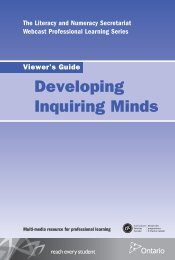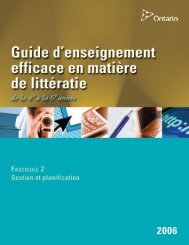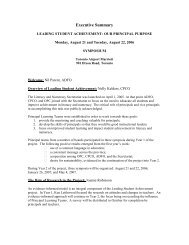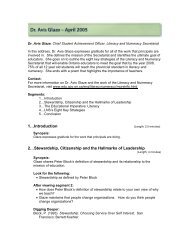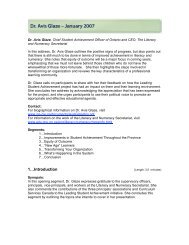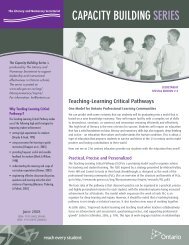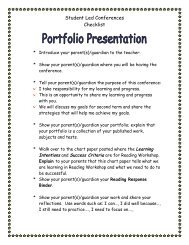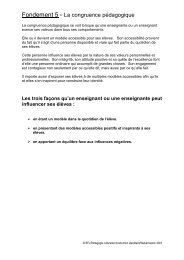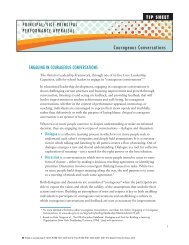Precision Teaching in the Primary Classroom Viewer's Guide
Precision Teaching in the Primary Classroom Viewer's Guide
Precision Teaching in the Primary Classroom Viewer's Guide
- No tags were found...
Create successful ePaper yourself
Turn your PDF publications into a flip-book with our unique Google optimized e-Paper software.
• Dur<strong>in</strong>g this shar<strong>in</strong>g session, students are encouraged to reflect on <strong>the</strong>ir<br />
learn<strong>in</strong>g and expla<strong>in</strong> <strong>the</strong>ir th<strong>in</strong>k<strong>in</strong>g. The teacher values students’ th<strong>in</strong>k<strong>in</strong>g<br />
and encourages <strong>the</strong>m to th<strong>in</strong>k deeply about <strong>the</strong>ir work. Students are<br />
develop<strong>in</strong>g <strong>the</strong>ir metacognitive awareness.<br />
• What strategies might you use to help students become more aware of<br />
<strong>the</strong>mselves as learners<br />
Inference Game<br />
In this clip, students are actively engaged <strong>in</strong> a game that re<strong>in</strong>forces <strong>the</strong>ir<br />
understand<strong>in</strong>g of <strong>the</strong> term “<strong>in</strong>ference.” The teacher pulls unfamiliar objects<br />
from a mystery bag and <strong>the</strong> students are challenged to <strong>in</strong>fer <strong>the</strong> function of<br />
each based on <strong>the</strong> “tool’s clues.” As <strong>in</strong>ferences are made, students provide a<br />
rationale for <strong>the</strong>ir th<strong>in</strong>k<strong>in</strong>g. Infus<strong>in</strong>g active games <strong>in</strong>to <strong>the</strong> teach<strong>in</strong>g-learn<strong>in</strong>g<br />
process is an effective way to engage students <strong>in</strong> practis<strong>in</strong>g a newly taught<br />
skill or strategy.<br />
• What do you th<strong>in</strong>k are <strong>the</strong> benefits to students and to teachers of this<br />
approach to guided practice<br />
• How might you modify this game to support your students <strong>in</strong> <strong>the</strong> content<br />
area <strong>the</strong>y are currently study<strong>in</strong>g<br />
Writ<strong>in</strong>g<br />
Success Criteria and Exemplars<br />
Students are learn<strong>in</strong>g how to write about <strong>the</strong> <strong>in</strong>ferences <strong>the</strong>y draw <strong>in</strong> relation<br />
to <strong>the</strong> characters <strong>in</strong> <strong>the</strong> texts <strong>the</strong>y are read<strong>in</strong>g. They have collaboratively<br />
created learn<strong>in</strong>g goals, success criteria and exemplars to guide <strong>the</strong>ir writ<strong>in</strong>g.<br />
These learn<strong>in</strong>g tools are posted <strong>in</strong> <strong>the</strong> classroom for students to refer to<br />
dur<strong>in</strong>g <strong>the</strong>ir writ<strong>in</strong>g. Before <strong>the</strong>y work on <strong>the</strong>ir <strong>in</strong>dividual writ<strong>in</strong>g, <strong>the</strong>y will<br />
have many opportunities to write with support from <strong>the</strong>ir peers and teacher.<br />
• Exemplars are helpful <strong>in</strong> clarify<strong>in</strong>g for students exactly what is expected<br />
of <strong>the</strong>m <strong>in</strong> <strong>the</strong>ir work. How would you encourage students to use <strong>the</strong><br />
exemplars dur<strong>in</strong>g <strong>the</strong>ir writ<strong>in</strong>g as part of <strong>the</strong>ir self-assessment<br />
• How might you use exemplars <strong>in</strong> science or social studies<br />
• What caution might you need to consider when us<strong>in</strong>g exemplars with<br />
students<br />
7





